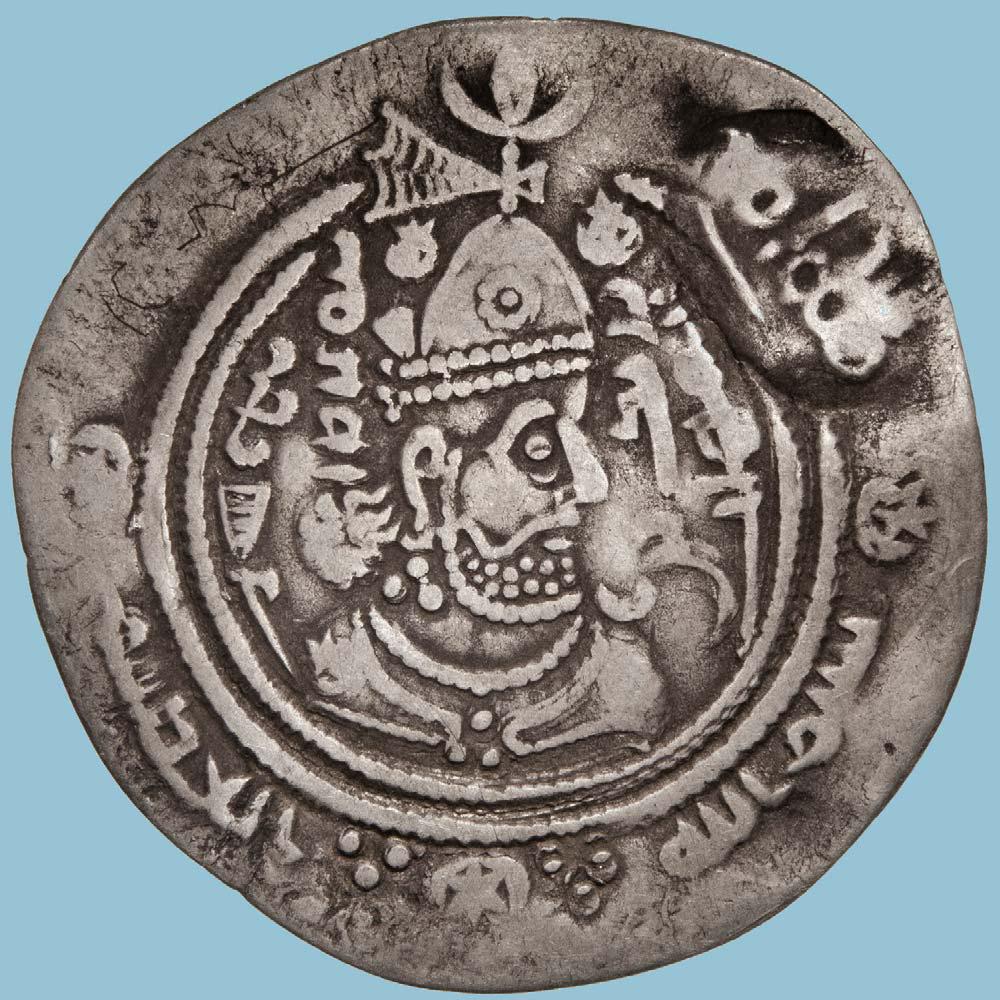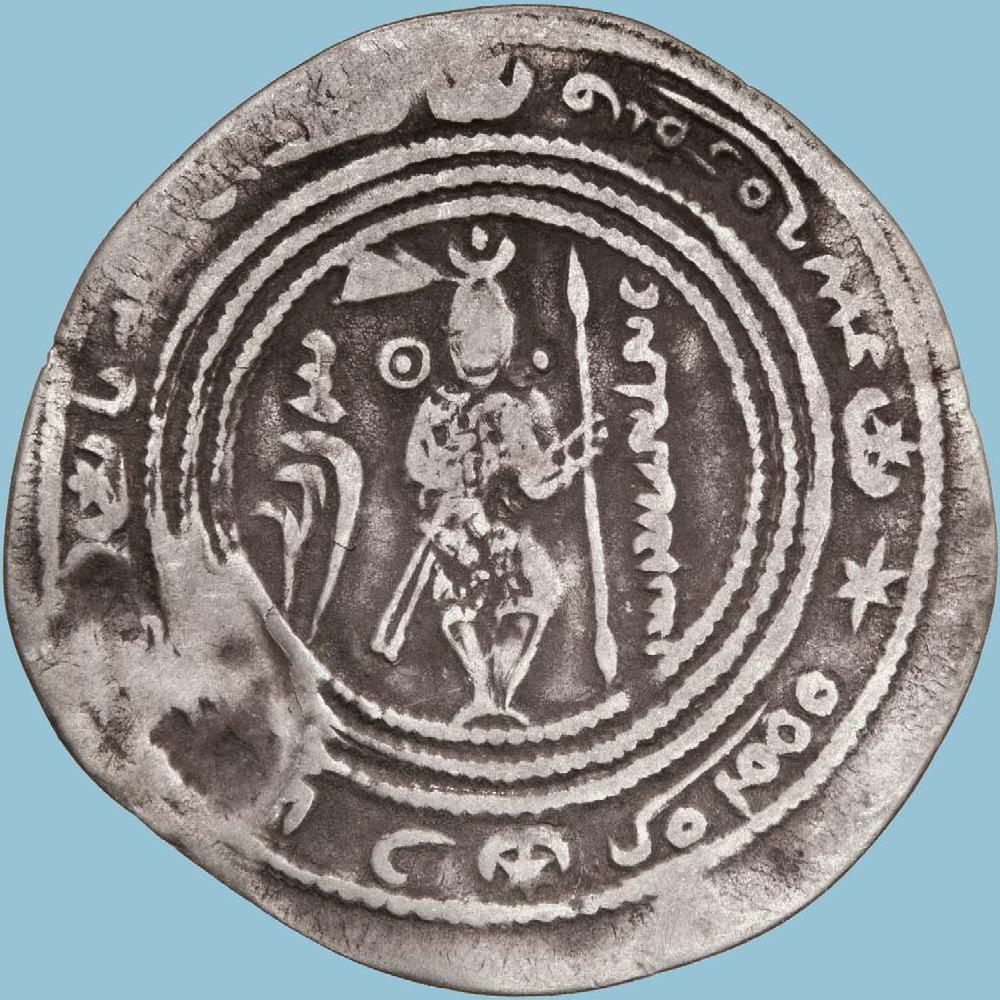Umayyad Coin of Yazīd ibn al Muhallab, early 8th century AD Obverse  Reverse | |
|
ARAB-EPHTHALITE, YAZID B. AL-MUHALLAB Drachm, ANBYR (Anbir) 84h | |
| OBVERSE: |
Sasanian bust right, wearing helmet with ‘weather-vane’ crest To right of bust, in Arabic: Yazid bin - al-Muhallab In second and third quadrants of margin, in Arabic: bismillah – al-a‘zim |
| REVERSE: |
Standing figure facing wearing armour and helmet with ‘weather-vane’ crest, holding spear vertically in left
hand, right hand on pommel of sheathed sword at his waist. In field (in Pahlawi) ANBYR to left, date to right In first and second quadrants of margin: Hephthalite legend In fourth and third quadrants of margin (in Arabic): duriba jizya bi-’l–Juzjan |
| WEIGHT: | 3.04g |
| REFERENCES: | Walker 1952, p.108, 3, same obverse die; Album E91 RRR |
| CONDITION: | Ephthalite countermark in first quadrant of obverse margin, flan slightly curved, otherwise good fine and of the highest rarity, an historically important coin |
| NOTE: |
This extraordinary type is one of the very latest Arab-Sasanian drachms issued.
It is exceptional in many respects, but the first and most obvious must be the remarkable depiction of the armed warrior on the reverse.
On virtually all Arab-Sasanian drachms the imagery is simply copied from Sasanian prototypes without conscious modification.
Even on the present coin, where the bust on the obverse has been modified to the extent of adding a distinctive helmet,
the features of the portrait have been left unaltered and are recognizably those of Khusraw II.
But the standing warrior on the reverse is an entirely different matter,
giving us as it does an accurate and naturalistic impression of the weapons and equipment of a Muslim commander of the first century Hijri. The figure on the reverse is fully armoured, and depicted with sufficient accuracy that the armour itself can be shown to be chain mail rather than scale or lamellar plate. The curved loops on the armour are intended to represent mail rings, while the mail tunic is clearly sufficiently flexible to fit the outline of the warrior’s body and extends down to his knees; below this, he wears greaves to protect his shins. The other main types of armour used at this time, scale or lamellar plate, were much more structured than mail and, being less flexible, would likely have been shorter. Another characteristic of chain mail is that it places almost all the weight of the armour on the shoulders, and one way of counteracting this was to wear a wide, strong belt which pulled the armour in. Such a belt is clearly visible both on the present coin and also on the piece published by Walker. The prestige of a coat of mail in the early years of Islam, as well as its practical defensive value, is explicitly stated in the Qur‘an:. ‘ It was We who taught hime the making of coats of mail for your benefit, to guard you from each other’s violence: will ye then be grateful?’ (Qur‘an 21:80) The warrior is not explicitly identified; he may be the caliph, Yazid b. al-Muhallab, or perhaps an idealised representation of an armed Muslim fighter. It seems unlikely that Yazid would have been so presumptuous as to place a depiction of himself explicitly on a silver coin, particularly at a time when Arab-Sasanian drachms were finally being replaced by purely epigraphic post-Reform dirhams. The bust on the obverse has the same helmet as the standing figure on the reverse, and does have the governor’s name before it, but in other respects the personal features of the bust are stereotypical and derived from their Sasanian prototype. It seems more likely that the figure is in fact the caliph himself, even though he is not labelled as on the celebrated ‘Standing Caliph’ drachms struck at Damascus in 75h. The obverse bust and the standing warrior on the reverse both sport the same distinctive pointed helmet, topped with what Walker termed a ‘weather-vane’ crest. There are plenty of precedents for this type of helmet both in Byzantium and the East, but it is exceptional and significant that the Sasanian royal bust on this coin should wear a military helmet rather than a crown. The impression is that the coin has a specific military purpose or significance, which the governor who issued it wanted to make as clear as possible. Yazid b. al-Muhallab succeeded his father, al-Muhallab b. Abi Sufra, as governor of Khurasan following the latter’s death in 82h. He had previously issued regular Arab-Sasanian drachms at six different mints in Kirman, all dated 78h (SICA 1, p.29, note 187), but otherwise does not appear on the coinage until this type was struck six years later. Walker, who read the mint-signature as HURA (for Khurasan) but otherwise interpreted the difficult and complicated legends remarkably well, tells us that ‘the Ephthalite leader Nizak…was actually besieged in his fortress at Badhghis, in Khurasan, by Yazid in the same year as that of our coin. All his treasures fell to Yazid after his capitulation. So Ephthalite tribute money is quite in historical perspective.’ This, Walker suggests, explains the reference to jizya in the reverse margin. He notes further that, while the terms jizya and kharaj were used in later times to mean a personal tax and a land-tax respectively, ‘in the early days of Islam they were interchangeable terms denoting tribute generally… According to Tabari, in Khurasan jizya was always said and not kharaj.’ Walker is surely right to link this issue with the siege of Badhghis and the capture of Nizak, but his suggestion of ‘tribute money’ presents some problems. Firstly, there is the definition: would ‘tribute money’ be struck by the Ephthalites to pay tribute to the victorious Muslims, or be struck by the Muslims themselves from the plunder of Badhghis to be sent back to Damascus? Neither of these seems satisfactory, and we know from other sources that the Muslims were happy to send plunder captured from non-Islamic peoples back to the capital in whatever form it was taken (including idols). Therefore, instead of being some kind of ‘tribute coinage’, it seems plausible to suggest that these coins were struck by the victorious Muslims to circulate locally. This would explain why the legends are given not only in Arabic and Pahlawi but also in the Ephthalite script, with the threatening warrior on the reverse placed there as an explicit warning and reminder to the defeated Ephthalites. With this in mind, if we then interpret the word jizya in its more usual sense of a poll-tax levied on non-Muslim subjects, such as the Ephthalites, we can envisage the Muslims requiring payment of this tax in a type of coin which was acceptable to them. With its traditional Arab-Sasanian Pahlawi mint and date, and other legends in both Arabic and Ephthalite, the present coin would fit that purpose admirably, while also being a highly symbolic token of Muslim military superiority. |
